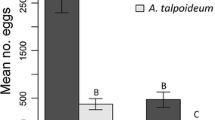Abstract
The feeding ecol ogy of the critically endangered Iberian lynxLynx pardinus Temminck, 1827, was studied in the most important remnant population, located in eastern Sierra Morena (Sierra de Andujar Natural Park, Spain). Three hundred sixty scats were collected from October 2001 through Sep tember 2002. RabbitsOryctolagus cuniculus dominated the lynx diet, as showed by frequency of occurrence (94%) and percent age of volume (91%). Red-legged partridgesAlectoris rufa were the most important secondary prey. No significant seasonal variation was observed regarding the diet preferences of the lynx. No difference was found in lynx diet by comparing two areas with high and low rabbit availability. Juvenile rabbits were positively selected when they were available, during late winter, spring and early summer.
Similar content being viewed by others
References
Aldama J. J., Beltrán J. F. and Delibes M. 1991. En ergy expenditure and prey requirements of free-rang ing Iberian lynx in SW Spain. The Journal of Wildlife Management 55: 635–641.
Aymerich M. 1982. Etude comparitive des regimes alimentaires du Lynx pardelle (Lynx pardina Temminck, 1824) et du chat sauvage (Felis silvestris Schreber, 1777) au cen tre de la peninsula Iberique. Mammalia 46: 515–521.
Beltrán J. F. and Delibes M. 1991. Environmental determinants of circadian activity of free-ranging Ibe rian lynxes. Journal of Mammalogy 75: 382–393.
Beltrán J. F. and Delibes M. 1994. Ecología trófica del lince ibérico en Doñana durante un periodo seco. Doñana Acta Vertebrata 18: 113–122.
Blanco J. C. and Villafuerte R. 1993. Factores ecológicos que influyen sobre las poblaciones de conejo. Incidencias de la enfermedad hemorrágica. ICONA, Madrid. Unpubl. Report.
Blanco Aguiar J. A., Virgós E. and Villafuerte R. 2004. Perdiz RojaAlectoris rufa. [In: Atlas de las Aves Reproductoras de Espańa. R. Martí and J. C. Del Moral, eds]. Dirección General de conservación de la Naturaleza-Sociedad Espańola de Ornitología. Madrid: 212–213.
Burnham K. P., Anderson D. R. and Laake J. L. 1980. Estimation of density from line transect sampling of biological populations. Wildlife Monographs 72: 1–202.
Calzada J. and Palomares F. 1996. Frecuencia de aparición de distintos restos de conejo en excrementos de lince y zorro. Doñana Acta Vertebrata 23: 243–252.
Delibes M. 1980. Feeding ecology of the Spanish lynx in the Coto Doñana. Acta Theriologica 25: 309–324.
Delibes M., Palacios F., Garzón J. and Castroviejo J. 1975. Notes sur l’alimentation et biologie du Lynx pardelle (Lynx pardina Temminck, 1824) en Espagne. Mammalia 39: 387–393.
Ferreras P., Aldama J. J., Beltrán J.F. and Delibes M. 1992. Rates and causes of mortality in a frag mented population of Iberian lynx (Felis pardina). Biological Conservation 61: 197–202.
Ferreras P., Beltrán J. F., Aldama J. J. and Delibes M. 1997. Spatial organization and land tenure system of the endangered Iberian lynx. Journal of Zoology, London 243: 163–189.
Fedriani J. M., Palomares F. and Delibes M. 1999. Niche relations among three sympatric Mediterranean carnivores. Oecologia 121: 138–148.
Gil-Sánchez J. M., Moleón M., Otero M. and Bautista M. 2004. A nine year study of successful breeding in a Bonelli’s eagle population in southeast Spain: a basis for conservation. Biological Conservation 118: 685–694.
Gil-Sánchez J. M., Molino F. and Valenzuela G. 1997. Nota sobre la alimentación del lince ibérico en el parque natural de la sierra de Andújar (Sierra Morena Oriental). Doñana Acta Vertebrata 24: 204–206.
Gil-Sánchez J. M., Valenzuela G. and Sánchez J. F. 1999. Ibe rian wild cat (Felis silvestris tartessia) predation on rabbits (Oryctolagus cuniculus): functional response and prey-age selection. Acta Theriologica 44: 421–428.
Manly B., McDonald L. and Thomas D. 1993. Resource selection by animals. Statistical design and analysis for field studies. London: Chapman and Hall: 1–844.
Nowell K. 2002. Revision of the Felidae Red List Threatened Species. Cat News 37: 4–6.
Nowell K. and Jackson P. 1996. Wild cats. Status survey and conservation action plan. IUCN, Gland: 1–382.
Palomares F., Ferreras P., Fedriani J. M. and Delibes M. 1996. Spatial relationships between Iberian lynx and other carnivores in an area of SW Spain. Journal of Applied Ecology 33: 5–13.
Palomares F., Ferreras P., Travaini A. and Delibes M. 1998. Co-existence between Iberian lynx and Egyptian mongooses: estimating interaction strength by structural equation modelling and testing by an observational study. Journal of Animal Ecology 67: 967–978.
Palomares F., Delibes M., Ferreras P., Fedriani J. M., Calzada J. and Revilla E. 2000. Iberian lynx in a fragmented landscape: predispersal, dispersal and postdispersal habitats. Conservation Biology 14: 809–818.
Palomares F., Delibes M., Revilla E., Calzada J. and Frediani J. M. 2001. Spatial ecology of Iberian lynx and abundance of European rabbits in south-western Spain. Wildlife Monographs 148: 1–36.
Palomares F., Godoy J. A., Piriz A., O’Brien S. J. and Johnson W. E. 2002. Faecal genetic analysis to determine the presence and distribution of elusive carnivores: design and feasibility for the Iberian lynx. Molecular Ecology 11: 2171–2182.
Robinson J. H. and Delibes M. 1988. The distribution of faeces by the Spanish lynx (Felis pardina). Journal of Zoology, London 216: 577–582.
Siegel S. 1956. Non-parametric statistics for the behavioural sciences. MacGraw-Hill, New York: 1–340.
Author information
Authors and Affiliations
Corresponding author
Additional information
Associate Editor was Krzysztof Schmidt.
Rights and permissions
About this article
Cite this article
Gil-Sánchez, J.M., Ballesteros-Duperón, E. & Bueno-Segura, J.F. Feeding ecology of the Iberian lynxLynx pardinus in eastern Sierra Morena (Southern Spain). Acta Theriol 51, 85–90 (2006). https://doi.org/10.1007/BF03192659
Received:
Accepted:
Issue Date:
DOI: https://doi.org/10.1007/BF03192659




